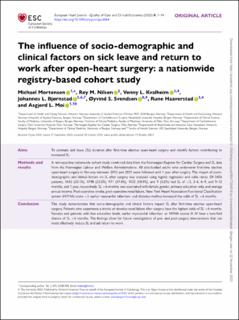The influence of socio-demographic and clinical factors on sick leave and return to work after open-heart surgery: a nationwide registry-based cohort study
| dc.contributor.author | Mortensen, Michael | |
| dc.contributor.author | Nilsen, Roy Miodini | |
| dc.contributor.author | Kvalheim, Venny Lise | |
| dc.contributor.author | BJØRNSTAD, JOHANNES | |
| dc.contributor.author | Svendsen, Øyvind Sverre | |
| dc.contributor.author | Haaverstad, Rune | |
| dc.contributor.author | Moi, Asgjerd Litleré | |
| dc.date.accessioned | 2023-11-24T07:13:16Z | |
| dc.date.available | 2023-11-24T07:13:16Z | |
| dc.date.created | 2023-11-06T15:55:33Z | |
| dc.date.issued | 2023 | |
| dc.identifier.citation | European Heart Journal - Quality of Care and Clinical Outcomes. 2023, 1-14. | en_US |
| dc.identifier.issn | 2058-5225 | |
| dc.identifier.uri | https://hdl.handle.net/11250/3104450 | |
| dc.description.abstract | Aims To estimate sick leave (SL) duration after first-time elective open-heart surgery and identify factors contributing to increased SL. Methods and results A retrospective nationwide cohort study combined data from the Norwegian Register for Cardiac Surgery and SL data from the Norwegian Labour and Welfare Administrations. All able-bodied adults who underwent first-time elective open-heart surgery in Norway between 2012 and 2021 were followed until 1 year after surgery. The impact of socio-demographic and clinical factors on SL after surgery was analysed using logistic regression and odds ratios. Of 5456 patients, 1643 (30.1%), 1798 (33.0%), 971 (17.8%), 1035 (18.9%), and 9 (0.2%) had SL of <3, 3–6, 6–9, and 9–12 months, and 1 year, respectively. SL >6 months was associated with female gender, primary education only, and average annual income. Post-operative stroke, post-operative renal failure, New York Heart Association Functional Classification system (NYHA) score >3, earlier myocardial infarction, and diabetes mellitus increased the odds of SL >6 months. Conclusion This study demonstrates that socio-demographic and clinical factors impact SL after first-time elective open-heart surgery. Patients who experience a stroke or develop renal failure after surgery have the highest odds of SL >6 months. Females and patients with low education levels, earlier myocardial infarction, or NYHA scores III–IV have a two-fold chance of SL >6 months. The findings allow for future investigations of pre- and post-surgery interventions that can most effectively reduce SL and aid return to work. | en_US |
| dc.language.iso | eng | en_US |
| dc.publisher | Oxford University Press | en_US |
| dc.rights | Navngivelse-Ikkekommersiell 4.0 Internasjonal | * |
| dc.rights.uri | http://creativecommons.org/licenses/by-nc/4.0/deed.no | * |
| dc.title | The influence of socio-demographic and clinical factors on sick leave and return to work after open-heart surgery: a nationwide registry-based cohort study | en_US |
| dc.type | Peer reviewed | en_US |
| dc.type | Journal article | en_US |
| dc.description.version | publishedVersion | en_US |
| dc.rights.holder | © The Author(s) 2023 | en_US |
| dc.source.pagenumber | 1-14 | en_US |
| dc.source.journal | European Heart Journal - Quality of Care and Clinical Outcomes | en_US |
| dc.identifier.doi | 10.1093/ehjqcco/qcad064 | |
| dc.identifier.cristin | 2192834 | |
| cristin.ispublished | true | |
| cristin.fulltext | original | |
| cristin.qualitycode | 1 |
Tilhørende fil(er)
Denne innførselen finnes i følgende samling(er)
-
Import fra CRIStin [3583]
-
Institutt for helse og funksjon [567]
-
Institutt for helse- og omsorgsvitskap [2721]

